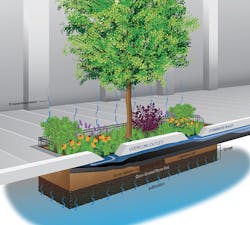In 2012, the New York City Department of Environmental Protection (DEP) launched a series of green infrastructure projects to improve stormwater management in the city and protect the health of local waterways. The agency has now constructed more than 4,000 rain gardens along sidewalks and stormwater green street projects along parking lanes, medians, and roadway areas throughout the city. DEP defines green infrastructure as an array of practices that use or mimic natural systems to manage stormwater runoff, with a goal of capturing and infiltrating the water and removing it from the wastewater system.
In Queens, the approximately 1,000-acre Newtown Creek CSO Tributary Area is among the DEP’s priorities. Newtown Creek is a 3.2-mile tributary of the East River and an estuary between the boroughs of Brooklyn and Queens. In order to manage the runoff and meet an aggressive Consent Order milestone schedule, the New York City Department of Design and Construction (DDC) contracted Dewberry to develop the green infrastructure installations. DDC serves as New York City’s primary capital construction manager, overseeing the delivery of civic buildings and infrastructure projects in all five boroughs, in addition to supporting Mayor de Blasio’s long-term vision of growth, sustainability, resiliency, equity, and healthy living. With the DEP as the sponsor agency, DDC asked Dewberry to site and design DEP’s right-of-way (ROW) rain gardens and stormwater green streets throughout the Newtown Creek CSO Tributary Area. Services for the project included:
- A Tributary Drainage Area analysis to determine potential rain garden and stormwater green street locations
- Field walkthroughs with DEP, the New York City Department of Transportation (DOT), and New York City Department of Parks and Recreation (DPR) to verify that runoff management locations met City guidelines
- Management and analysis of subsurface geotechnical investigations to determine soil conditions and permeability rates so the rain gardens and green streets could infiltrate the stormwater
- Management of survey efforts to follow DEP limited survey procedures requiring quality design and construction
- Creating contract plans using DEP’s standard details for the rain gardens and green streets, along with construction support
Custom GIS Tools to Delineate Drainage Areas
Dewberry began by developing custom tools to automate the process of locating the rain gardens and stormwater green streets. Innovative GIS applications helped delineate tributary drainage areas according to DEP’s standards. A custom tool was also written in Visual Basic to automatically locate the placement of rain gardens based on the drainage area analysis. The GIS rain garden placement tool determined the slope of the street and placed rain gardens accordingly based on the drainage area size, pavement edge length, and the flow direction of the street.
Dewberry also developed a custom script for GIS field collections on a mobile tablet. This application allowed for the collection of large amounts of GIS field data and smoothly integrated the data into desktop GIS analysis. The solution enabled the quick turnaround of updated maps that were needed for field meetings with DOT, DPR, and DEP. This tablet-based script also allowed for rapid updating of agency-approved rain garden and stormwater green street locations on mapping products for submittal to the geotechnical and survey subconsultants on the team.
Geotechnical challenges included limits on drilling and conducting permeability tests during the winter months, requiring efficient management of the project schedule. Deliverables included a geotechnical pre-drilling checklist for DEP that was used as a standard for all consultants on the installations.
Today, 1,327 green infrastructure assets, including ROW rain gardens and stormwater streets, are helping to improve Newtown Creek. According to the DEP 2018 Green Infrastructure Annual report, since 2010, green infrastructure improvements in the Newtown Creek Watershed have managed just over 152 million gallons of stormwater, the equivalent of 122 greened acres. The 2018 report can be viewed on the DEP website at www1.nyc.gov/site/dep/water/green-infrastructure.page.
Design and final construction of 298 rain gardens and stormwater green streets in the Newtown Creek Tributary were done by Dewberry. The curbside rain gardens, up to 20 feet in length, and green streets, which can be larger, have substantially reduced the quantity of water going into the catch basins and reduced the combined sewer overflow (CSO) volume discharged into the creek. The collected stormwater is absorbed by the sandy, engineered soil in the top layer, then drains through a stone layer along the bottom where it seeps into the ground below. During a heavy rainstorm, if the rain garden reaches capacity, the stormwater overflows at the outlet and flows into the catch basin.
The plants and trees in these green infrastructure installations have created greener, more beautiful streets for the Queens community. The planting plans were developed based on careful site analyses, including a review of the amount of sun, shade, and wet or dry conditions in each location. Plants include numerous native perennials, flowering bulbs, and shade trees. The shade from the trees serves to lower street temperature during hot summer days, and the plants and trees also cool and clean the air by absorbing stormwater through their roots and releasing oxygen and water vapor through their leaves. Rain gardens constructed along low points of the streets help reduce localized flooding as well. DEP is currently conducting research on the performance of these rain gardens and green streets and will publish the results in its annual report, available on the agency’s website. The Newton Creek Tributary project in Queens was recognized with a 2019 Platinum Award from the American Consulting Engineers Council (ACEC) New York chapter in recognition of its innovative use of technology and positive impact on the community and the environment. DEP’s green infrastructure projects, designed under the management of the NYCDDC, have demonstrated their benefit as an ecological framework for the social, economic, and environmental health of these communities. They have improved water quality by reducing the combined sewer overflow into surrounding waterways and helped build more sustainable, resilient communities by using stormwater as a resource for the natural landscape of the plants and trees.







